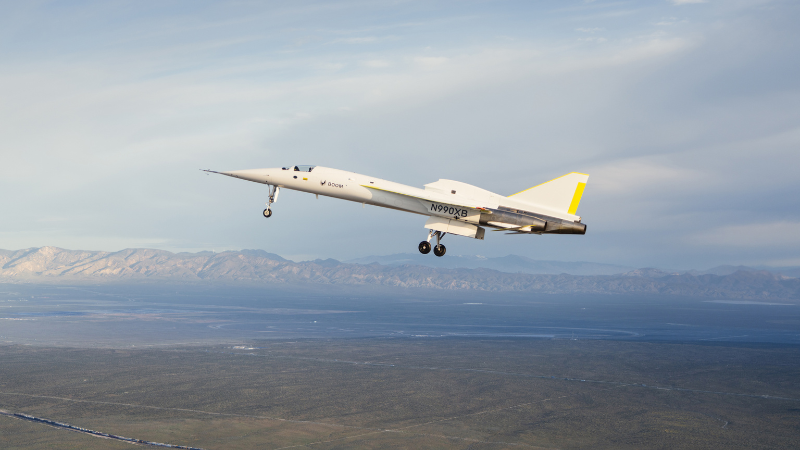

Image Courtesy: Boom Supersonic
Roughly a decade after the company was founded, Boom Supersonic conducted the first successful flight of its demonstrator aircraft, the XB-1. This historic test flight is a major step forward for the company and marks the next step of its development process.
To understand why this is so monumental, we’ll look at the flight, what it achieved, and what this means for the future of air travel.
The Boom XB-1, known affectionately as “Baby Boom” is a demonstrator aircraft of the company’s larger planned aircraft, the Boom Overture. After its initial unveiling in 2016, Boom Supersonic has conducted several years of design testing to reach the point where it could conduct its first test flight.
This happened in late March 2024 at the Mojave Air & Space Port, which has been the site of several landmark flights. Boom states that the flight met all of its goals, including reaching the planned altitude of 2100m and speeds of 238 knots. It also validated all the modern safety developments built for the test aircraft, which will be carried forward into the Overture design.
It would be impossible to discuss commercial supersonic aviation without mentioning Concorde. More than 20 years after it was retired, Boom Supersonic is carrying on the legacy of one of the most famous aircraft of all time.
It would be fair to say that Concorde, understandably, retired with a somewhat tarnished reputation. Project overruns and cost increases led to it having a rocky start, which was only exacerbated by the fatal crash in July 2000. And, with only 20 ever being built, Concorde was arguably slightly before its time.
However, Boom Supersonic has made some important strides in terms of safety and efficiency. For example, it replaces Concorde’s droop nose with augmented reality cameras. This improves the aircraft’s aerodynamics while also providing a high-resolution runway display with added data about flight paths and altitudes.
Then there’s the aircraft’s carbon fibre composite body. Aerospace engineering has come a long way since Concorde, and this is perhaps most obvious in the XB-1’s body and engines. Made almost entirely from carbon fibre composite, the aircraft is incredibly lightweight for its size, and very strong.
The Symphony engine is another impressive leap in technology. It’ll run on 100% SAF and will convert kinetic energy into pressure energy to more efficiently achieve supersonic speeds. Combined with the design’s digitally optimised aerodynamics, the XB-1 and Overture will be very safe and efficient aircraft.
The bottom line is that the XB-1’s test flight, and what this means for the Overture, is a vital step forward for commercial aviation. Development of this technology has come a very long way since Concorde, and this is evident in almost every element of Boom’s designs. Whether we look at the digitally designed aircraft or the use of carbon fibre, the modern aerospace industry has been very good for supersonic flight.
But what does this mean for the commercial aerospace industry more widely? If nothing else, we will likely see other companies empowered by the decisions Boom has made. For example, building a supersonic aircraft that runs on 100% sustainable fuel should be a useful push forward for subsonic aircraft manufacturers.
With the Overture due for commercial release in 2030, and with around 130 pre-orders in place, we may well see Boom Supersonic commercial supersonic flight like never before.
